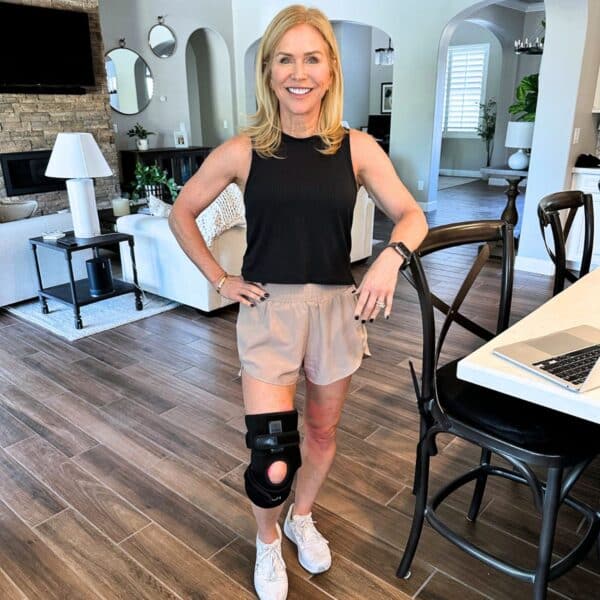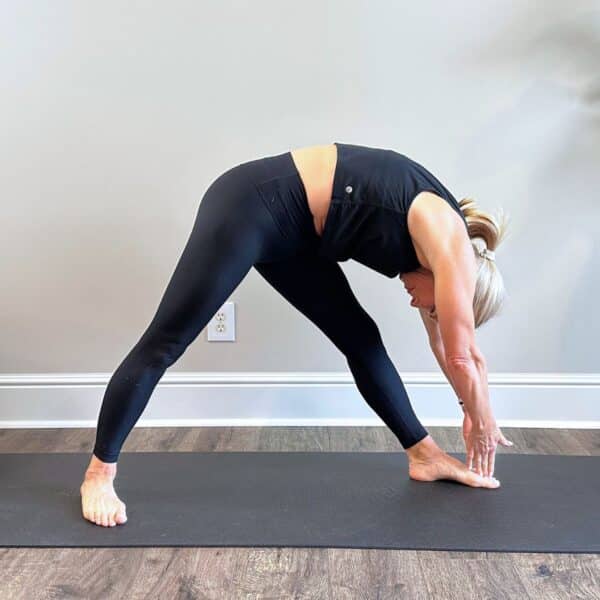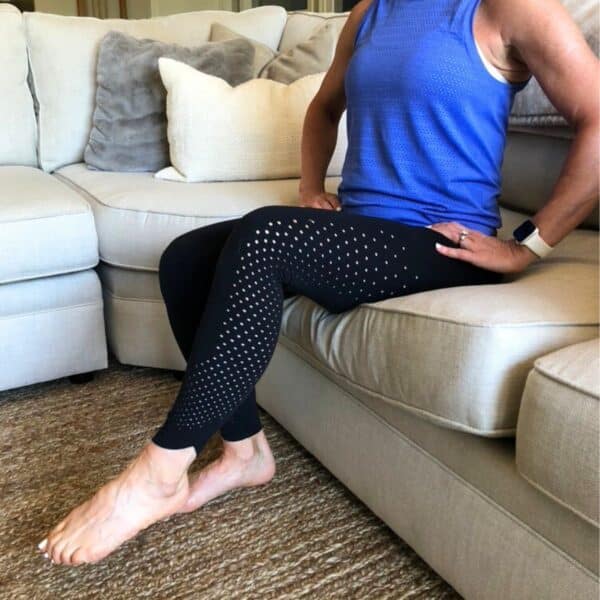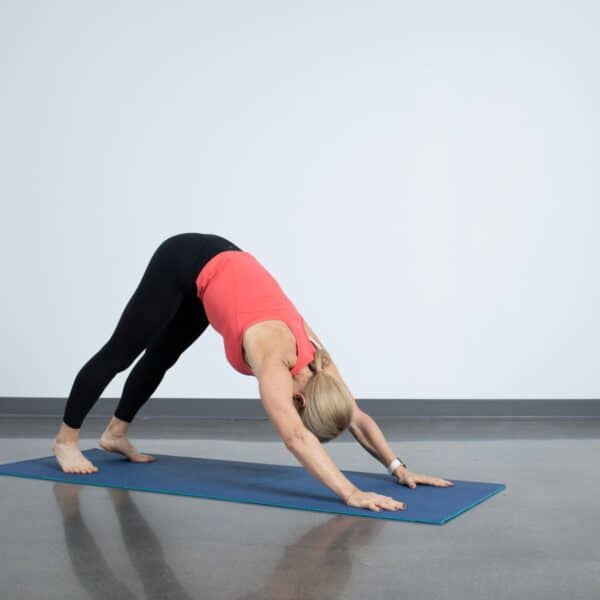This post contains affiliate links. Please see our disclosure policy.
Are you wondering how many steps a day you need to lose weight? Have you set a goal to walk 10,000 steps a day?
You’ve probably heard from fitness pros and even your doctor that walking 10,000 steps per day will keep your heart healthy, help you lose weight, and boost your fitness level. And it’s true: walking 10,000 steps per day is a good amount to strive for in order to stay healthy.
But when it comes to actually losing weight from walking, there are other factors involved.
- Are you consistently moving throughout the day or just crashing on the couch after those 10,000 steps are reached?
- How fast are you walking, and at what intensity?
It turns out that speed, intensity, and consistency actually matter more than just a step number if you’re serious about weight loss.
Let’s explore where the idea of 10,000 steps came from and the other factors you may need to consider if you really want to change your body.
Table of contents
Why 10,000 Steps a Day?
10,000 steps isn’t a magical number. In fact, its origins date back to a 1960s marketing campaign (sigh…doesn’t everything?)
Shortly after the 1964 Tokyo, Olympic games (and partially because of excitement generated by the events) consumers in Japan started snatching up a pedometer called the manpo meter.
The word “manpo” translates to 10,000 steps. Japanese fitness enthusiasts began to count their daily 10,000 steps to boost their health.
 Image Credit: Yamasa Tokei
Image Credit: Yamasa Tokei
In recent years (and since the rise of Fitbits and other wearable activity trackers) researchers have studied that recommendation and found that indeed, walking 10,000 steps a day can boost heart health and improve overall wellness—with two caveats.
Firstly, since not everyone is a walker, most health experts and organizations (like the American Heart Association) have now expanded the recommendation to simply ask that you participate in 150 minutes of moderate exercise per week, whether it’s walking, swimming, elliptical, or another form of cardiovascular exercise.
Secondly, if serious weight loss is your goal, don’t confuse the steps recommendation with a serious weight loss program.
While getting in your steps is important, the speed and intensity with which you move will matter more than a particular number when weight loss is your goal.
Related: 3 Walking Workouts To Boost Your Weight Loss
3 Things To Add To Your Walking Program If You Want To Lose Weight
When you start a walking program, you should first focus on building a consistent program to just get in the habit of walking. If you’re currently sedentary, start your program by trying to walk for 15-20 minutes most days of the week.
Gradually build upon that until you are walking almost every day. Then slowly add minutes to your session until you are walking for 30-40 minutes on most days.
One of the easiest ways to add walking to your routine is to incorporate it into your workday. With a quick swap to a standing desk and walking pad, you will be astounded at the number of steps you reach each day!
Once you’ve got a regular walking program in place, add these three challenges to make your walking program especially effective. By incorporating these three factors into your walks, you’ll lose weight, tone up, and start to see real changes in your body.
1. Speed
There is scientific evidence to suggest that people who walk at a brisk pace live longer than those who walk at a more leisurely pace (slower than a 24-minute mile). While we don’t know for certain that walking faster makes you live longer, it’s a great incentive to challenge yourself and burn a few extra calories.
If you don’t have a fitness tracker that displays walking speed, you can check your pace manually.
See how long it takes to walk a course and challenge yourself to decrease the time by thirty seconds, then one minute, then two minutes.
2. Hills
If you’re walking outdoors, try to find some hills in your neighborhood to work with; even a slight incline is fine to start with. If you’re stuck inside on a treadmill, use technology to make your workout more effective.
Set the speed to a comfortable walking pace, then add an incline to make the workout harder.
A 135-lb woman who burns 310 calories walking on a level surface will burn an extra 70 calories by adding a 7% incline.
3. Intervals
Studies have shown that brisk walking intervals are a more effective way to burn calories, so don’t be afraid to mix up your pace every few minutes or so, alternating from a brisk pace to a full-out power walk and back again.
One study conducted at Ohio State University found that walkers who varied their pace burned 20 percent more calories than those who walked at a steady pace.
Lastly, if your goal is weight loss, try to set a steps-per-day goal that is independent of exercise.
For example, if you set a goal to walk 10,000 steps per day, you might reach that goal with an early morning jog. But that doesn’t mean you should sit on the couch for the rest of the day.
Reaching that 10,000 steps marker is not an excuse to be sedentary for the rest of the day. You should incorporate movement into your entire day if you want to live longer, lose weight, and get in shape.
What Are The Benefits of Walking?
There are so many amazing benefits of walking workouts.

Lower Stress Level
Walking has huge mental health benefits. Studies have shown that outdoor exercise can help to improve your outlook on life and decrease stress levels.
If you walk outdoors as often as possible you’ll be able to enjoy not only the fresh air but also a fresh outlook.
Improved Metabolism
Walking also has metabolic benefits. A 140-pound woman burns about 130 calories during a brisk 30-minute walk. That’s about 100 calories more than she would burn sitting in front of a television or working at her desk at the office.
If you walk for 30 minutes every day, your weekly calorie expenditure would increase by a whopping 700 calories with a daily walk.
Related: How To Increase Your Metabolism In 5 Steps
Greater Range Of Motion In The Hips
The movement generated by striding forward requires both flexion and extension in the hip joint. Many of our typical daily activities require flexion only at the hip joint.
The extension (the part of your walking stride when your leg moves behind your body) helps to improve hip flexibility and overall range of motion in the lower body.
Improved Strength
Want stronger legs and a tighter backside? Walking engages the quadriceps, the hamstrings, and the gluteal muscles. If you walk with the good posture you can also engage and strengthen the abdominal area.
Daily Walking Leads To Weight Loss
Walking is something almost anyone, at any fitness level can do to lose weight. Constantly walking is a form of cardio that is low impact and can be done well into old age. Making walking a habit will lead to weight loss.
Final Thoughts: How Many Steps A Day You Need to Lose Weight
The truth is, walking is one of the most beneficial mind-body activities you can do. Whether you get 1,000 or 20,000 steps in a day – if you’re walking, you’re moving toward better health.
As for weight loss, the number of steps matters along with the other factors we mentioned like intensity and consistency.
As a general rule, aim for 10,00 steps a day but be sure to enjoy yourself in the process! Set a step goal that feels doable and move up from there.
Walking for Weight Loss Workouts To Try
Power Walking For Beginners
With countless studies proving the effectiveness of power walking in benefitting your health, learning how to power walk will keep you moving well into your future as you age. Power walking is one of the most maintainable workouts a person can add to their life so if you haven’t pursued the world of power walking
3 Walking Workouts For Weight Loss
If you want to start working out or simply get back in shape after taking a break from exercise, there’s no better—or more convenient—form of exercise than walking. Walking is low-impact and doable for almost everyone, but if weight loss is your goal, we’re here to tell you that intensity is the key to success.
Walking For Weight Loss | Your 14-Day Plan
Guess what, my friends, walking works. Study after study proves that people who walk regularly stay more youthful, stronger, and happier in old age. To get started, try my free 14-day challenge and get walking for a weight loss plan. Whether you like to walk on a machine, around your workplace, or in your neighborhood,
 Image Credit: Yamasa Tokei
Image Credit: Yamasa Tokei









one step = 0.5 m => 10,000 steps = 5000 m = 5 km
Walking 5 km/day, are you sure?
Hi Adelaide – yes 10,000 steps (roughly 5 miles) is the recommended daily amount: http://www.cnn.com/2015/12/21/health/ten-thousand-steps-better-health/
10,000 is no magic number. I see people who wear their fitbit and literally march in place in stutter steps to get that number! lol I just feel there should be a bit of effort involved?
I have a Fitbit with a heart rate monitor, and would love to challenge myself and my friends to BURN CALORIES, not to just hit this arbitrary number of steps. But the Fitbit app doesn’t provide calorie burn challenges, just step challenges. (which i can meet while strolling around the mall with little exertion & eating donuts lol)
Hi Shelley – I cannot tell you that information. You’ll have to get a step tracker! Here’s one I’ve tried before and liked: https://gethealthyu.com/my-experience-with-the-tomtom-touch-fitness-tracker/
I have been on a walking regimen for a year now, I have a goal of 12,000.00 steps a day, I make sure to stay active during the day also, I turn daily chores into a workout, I have went from 208lbs to 142lbs, it does work, you have to be consistent. I am so much healthy and happier.I will never go back to my old lifestyle…
My daily goal of walking is more than 10,000 steps. Walking has made my life a bit simpler and happier. I have also lost my weight. I have experienced many internal changes in my body.
Thank you for sharing your knowledge..
A balanced diet and adequate exercise were considered to be a necessary part of everyday life until recently. Food processing and the shift from physical to mental labor have resulted in a sedentary lifestyle and poor diet. Just as human creativity has resulted in a decrease in lifestyle efficiency, you can also discover ways to bundle healthy living in a convenient on-demand format.